Health workers once saluted as heroes now get threats


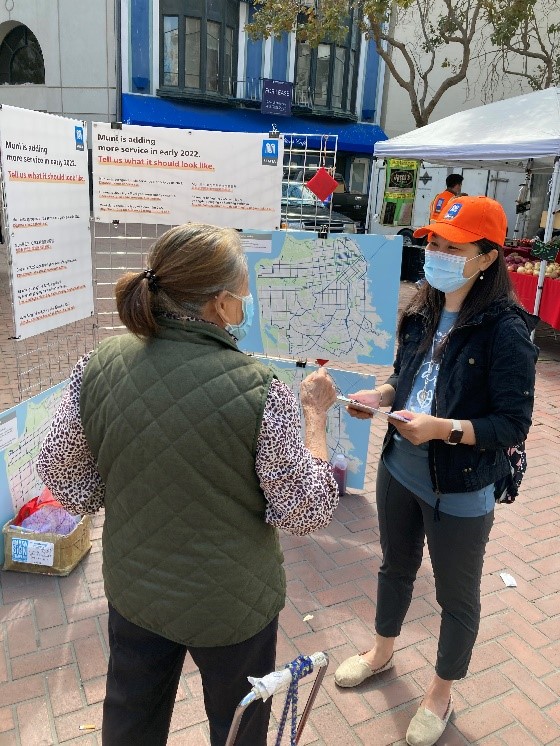

SFMTA staff talks with customer about 2022 Muni service options at farmer’s market pop-up event.
The SFMTA recently introduced three options for increasing Muni service in early 2022. We launched efforts to get community input on them, including a brief survey that closes Friday, October 1. If you haven’t taken the survey yet, there are still a few days left! You can find the survey link at SFMTA.com/2022Network.
We’ve received more than 4,000 survey responses so far and a few hundred calls to our hotline and feedback to our TellMuni@SFMTA.com email. You can also provide feedback on the shortened J Church route and changes to the 23 Monterey, 57 Parkmerced, 35 Eureka and 48 Quintara/24th Street by contacting TellMuni@SFMTA.com or 415.646.2005.
All three alternatives to increase Muni bus service in early 2022 have the same amount of total bus service – they’re just arranged differently. The “Familiar” alternative uses available resources to bring back the seven all-day Muni bus lines that have yet to restored since the pandemic began. The “Frequent” alternative instead uses the available resources to reduce wait times and crowding on Muni’s highest ridership lines (and does not restore those seven all-day bus lines). The “Hybrid” alternative aims to balance more routes and more frequency.
We’ve talked with over 30 stakeholder groups, a couple hundred attendees at our virtual meetings and several hundred more community members at tabling events and pop-ups in neighborhoods throughout the city.
Once our survey closes this Friday, our transit planners will use the input, paired with data that shows which lines are being used most and where ridership is highest, to develop a single proposal for increasing Muni service in early 2022. The proposal is expected to be ready in mid-October. We will also share details about how the survey results and other public feedback influenced the proposal.
After we release our proposal for early 2022 Muni service additions and changes, we will seek public feedback and refine the proposal in October and November. You will also have a chance to give input at upcoming open houses and office hours, by contacting TellMuni@SFMTA.com or 415.646.2005 and by taking our proposal survey in October.
The proposal for Muni service in early 2022 will be brought to the SFMTA Board for its consideration in December.














































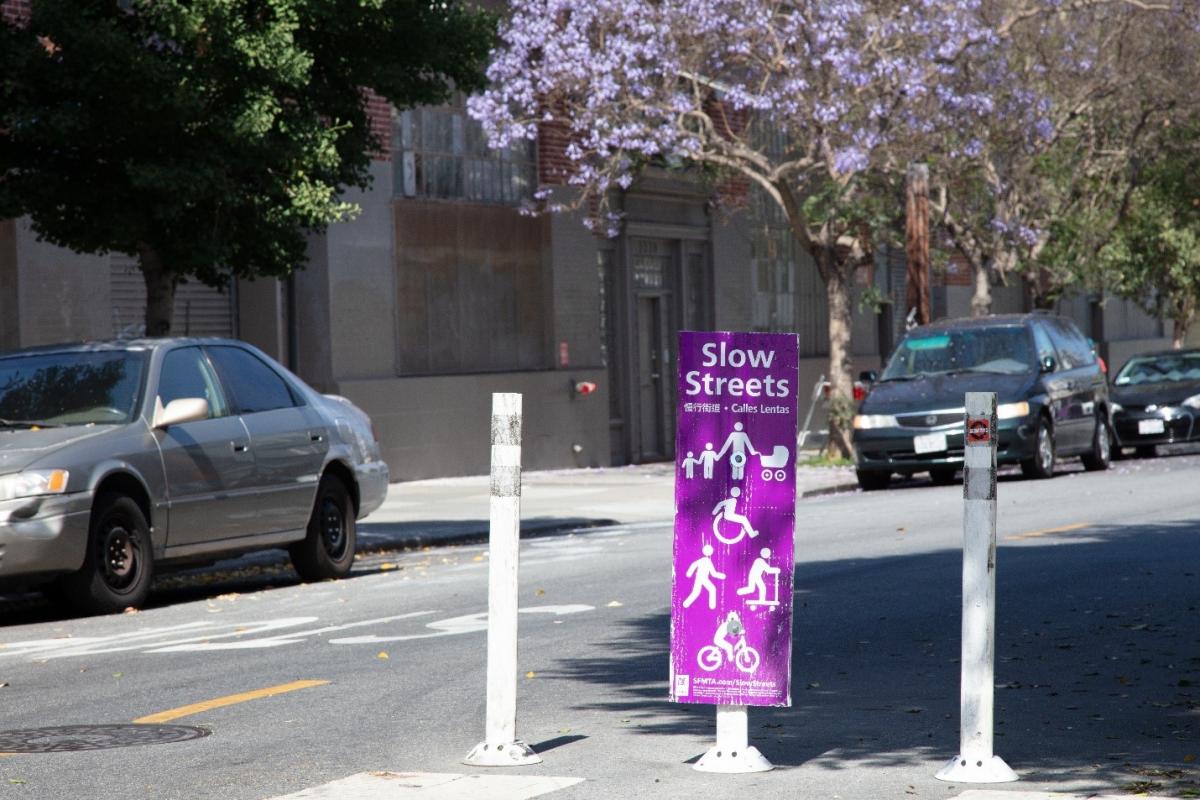

After over a year of Slow Streets providing safe, low-volume corridors for people to walk, bike, play and travel during the pandemic, we’re excited to share our first comprehensive evaluation of the program. The key takeaway? San Franciscans are overwhelmingly in support of Slow Streets.
Slow Streets are designed to limit through traffic on certain residential streets and allow them to be used as a shared roadway for people traveling by foot and by bicycle. Since introducing Slow Streets in April 2020 in response to the Mayor’s Emergency Health Order, SFMTA has designated around 30 corridors covering 47 miles of roadway as Slow Streets. The program has evolved from a critical component of San Francisco’s pandemic response and recovery to a potential new avenue to further the city and SFMTA’s goals around climate action and sustainable transportation.
As the Slow Streets program has grown, we wanted to make sure we were understanding its impact on residents and city streets. Over the course of the program, we sent out a mail survey to anyone living within 0.25 mile of a Slow Street. We received over 15,000 responses on overall opinions of the program, how frequently residents use the streets, their experience when doing so and if they’d like to see the program continue. In tandem, we analyzed data on traffic volumes, vehicle speeds, collisions, bicycling and pedestrian volumes and spillover traffic impacts on adjacent streets to understand how the Slow Streets designation is changing conditions along the corridors.Through this initial evaluation, we were able to answer some of the main questions about Slow Streets that have come up over the past year and a half:
How do people feel about Slow Streets?
Residents who responded to the survey overwhelmingly supported the program. And, they noticed improvements in safety across the board: 71% agree that a street designated as a Slow Street became safer after the change.
Do Slow Streets impact traffic conditions on surrounding streets?
Our analysis of traffic data on adjacent streets shows that overall, Slow Streets do not cause an increase in traffic. We recognize, though, that COVID impacted traffic volumes throughout the city and we will continue to monitor for impacts as traffic conditions evolve.
Does a Slow Street designation make the road safer?
Of the Slow Streets in the network, 100% met the baseline conditions for a low-stress facility—fewer than 3,000 average daily vehicles and typical vehicle speeds of less than 25 mph. After a street is designated as a Slow Street, it sees, on average, a 35% decrease in daily traffic and a 14% decrease in vehicle speeds—along with a 36% decrease, on average, in collisions across the network.
Do Slow Streets encourage more people to walk or bike? In evaluating the Slow Streets program, we saw a virtuous cycle unfold: The less traffic on the street, the more likely people are to use it for biking and walking—and the more people use the street for safe and sustainable transport and play, the more likely others are to join in. Seeing young people learning to ride bikes on a number of Slow Streets was a sign that the roads were safe enough for all users.
This Evaluation Summary shows data spanning from June 2020 through July 2021 for each of the corridors in the program, with a handful of exceptions that are outlined in the report.
Next Steps
As San Francisco continues to move through the COVID-19 crisis, we are beginning the process of transitioning Slow Streets to from an emergency response measure to an ongoing program. We were able to use the data shown in this report to determine the first four corridors to remain in place after the pandemic: Sanchez Street, Shotwell Street, Golden Gate Avenue, and Lake Street. More information about the plans for these streets is available at Post-Pandemic Slow Streets.
We will continue to evaluate all existing Slow Streets to determine their post-pandemic future. To learn more about the overall program, visit Slow Streets.






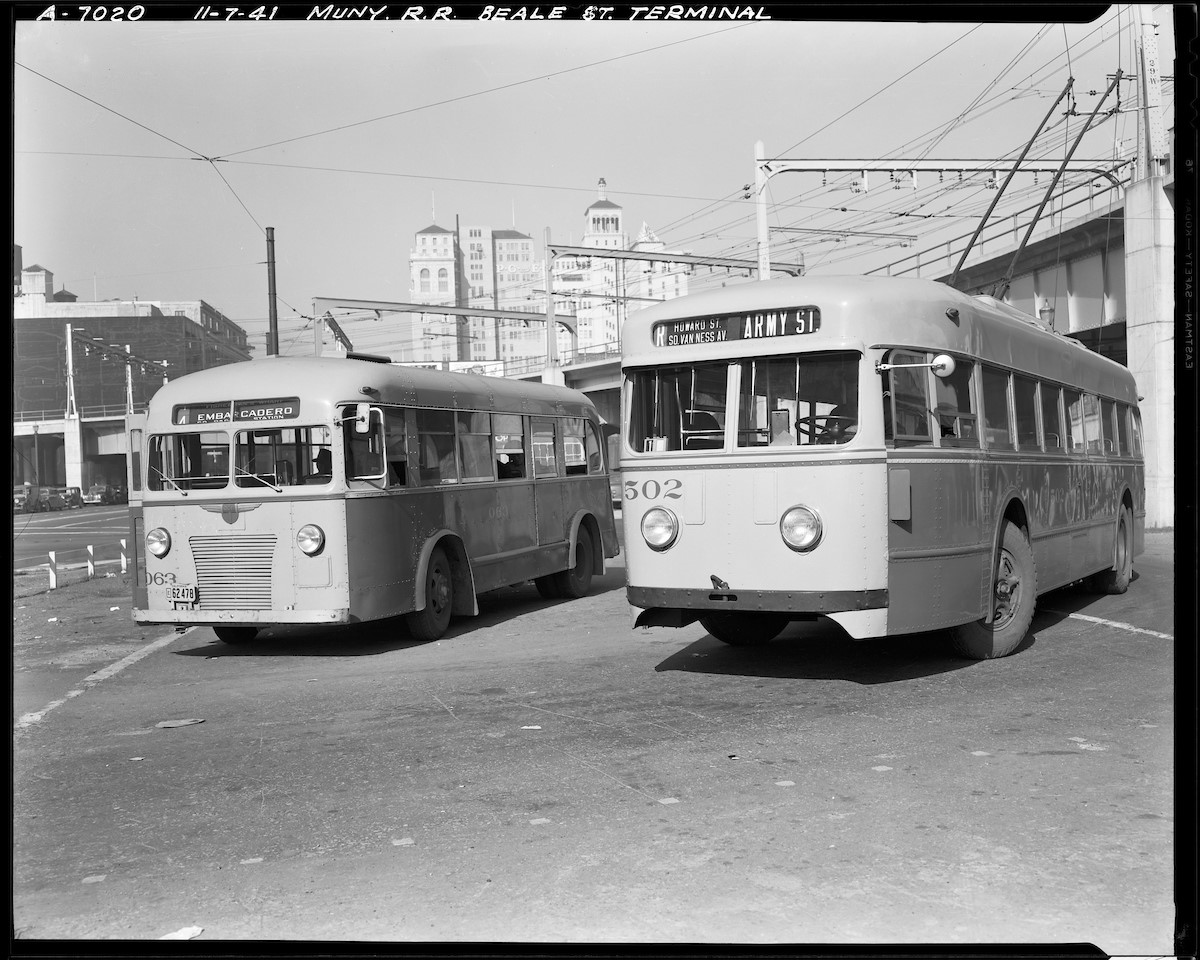
Eighty years ago on September 7, 1941, the San Francisco Municipal Railway launched its first all-electric bus route, the R Howard. Today the route no longer survives in its original form but the legacy of the R lives on in our electric trolley bus fleet and bus routes that serve the same area.
 Two Muni buses lay over at the “Bridge Terminal” at Beale and Howard Streets in this November 1941 photograph. At left is the 4 Embarcadero, which ran along the waterfront and the recently established R Howard trolley bus at right.
Two Muni buses lay over at the “Bridge Terminal” at Beale and Howard Streets in this November 1941 photograph. At left is the 4 Embarcadero, which ran along the waterfront and the recently established R Howard trolley bus at right.
The R traces its lineage back to the 35 Howard streetcar line, operated by the Market Street Railway Company. This line ran from the Ferry Building to 24th and Rhode Island Streets on Howard and South Van Ness. In 1939, when the company’s agreement to run the 35 expired, the city decided to establish the R Howard in its place. Electric trolley buses were chosen for the new service for their low cost of operation and to test the viability of these uncommon vehicles.
While the privately-operated 33 Ashbury/18th was the very first trolley bus route in the city, the launch of Muni’s R line marked the beginning of a new era for electric buses in San Francisco. Just a few years after starting the R, Muni decided to build on its positive experience with the route by converting many streetcar lines to trolley bus operation. Electric trolley buses were a natural choice for San Francisco because they could handle the hills without problems and utilize (with modification) the existing overhead electrical system that powered the streetcars they replaced. Add to that a lower cost of operation and these buses became the highest earning mode in the Muni system during the early 1950s.
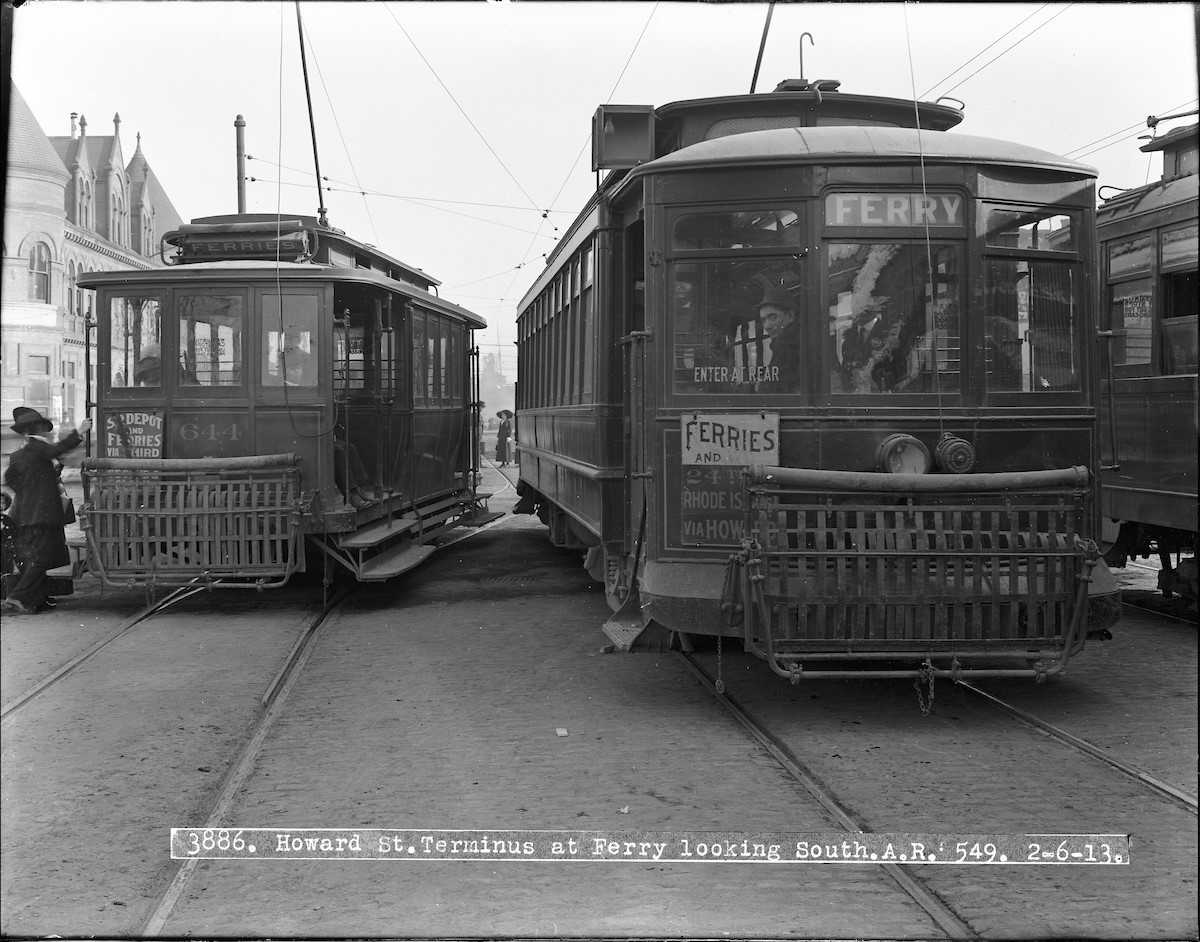 In this 1913 photo, streetcars await passengers at the terminal of the Howard Street Line just south of the Ferry Building.
In this 1913 photo, streetcars await passengers at the terminal of the Howard Street Line just south of the Ferry Building.
In 1947, the R was combined with the E Union streetcar line to form the 41 Union-Howard route. Connecting the Presidio to the Mission via Russian Hill and Downtown, the 41 covered nearly 7 miles one-way. Over 20 years later in 1970, the route was modified again when Howard Street was converted into a one-way street. The 41 was split in two with the portion north of Howard remaining the 41 and the southern portion becoming the 12.
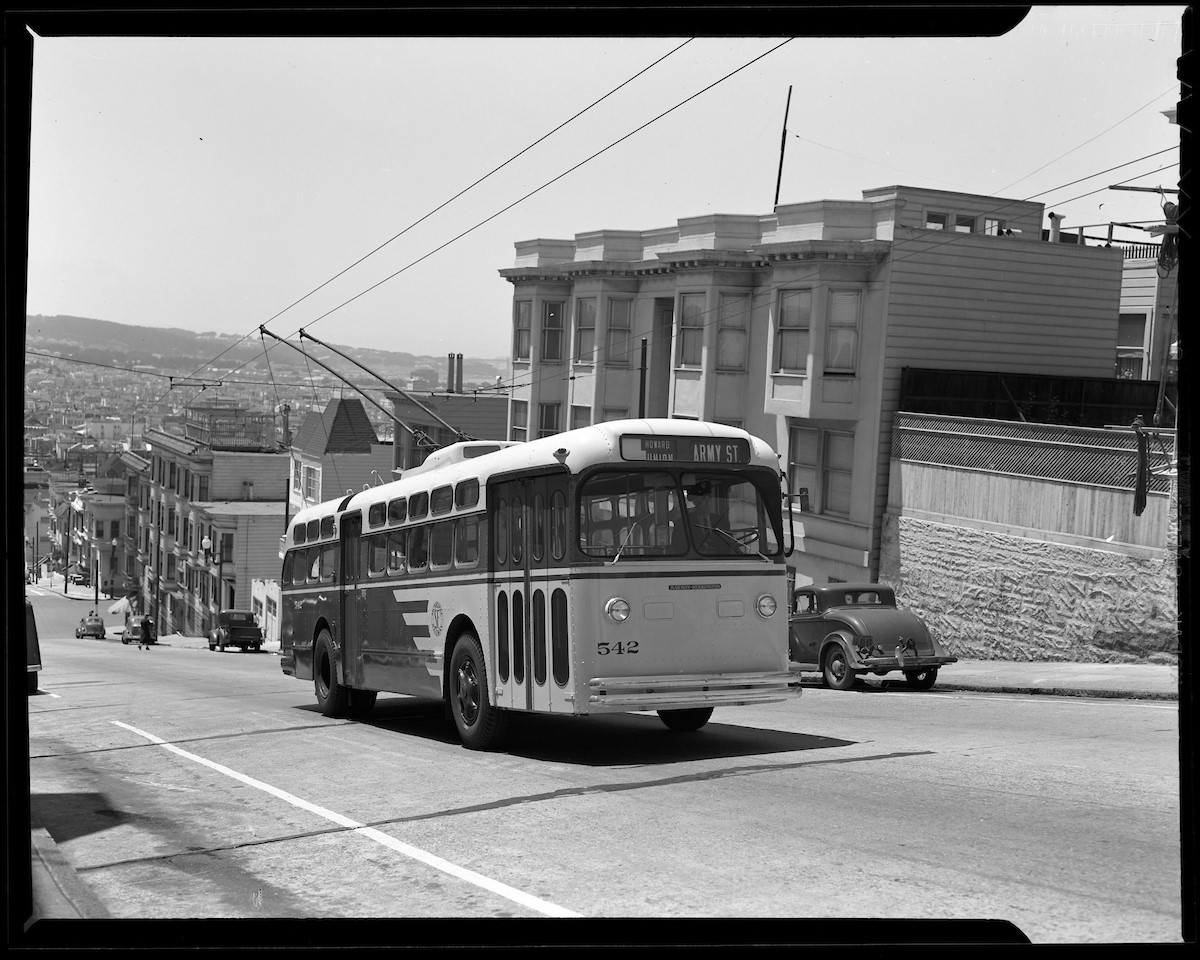 The 41 Union-Howard climbs Russian Hill heading for its terminal in the Mission in this 1948 photo taken on Union Street.
The 41 Union-Howard climbs Russian Hill heading for its terminal in the Mission in this 1948 photo taken on Union Street.
Today, the legacy of the R continues in the 12 Folsom-Pacific, which serves the original area of the R Howard, and in the numerous trolley buses that tirelessly climb hill after hill.




























































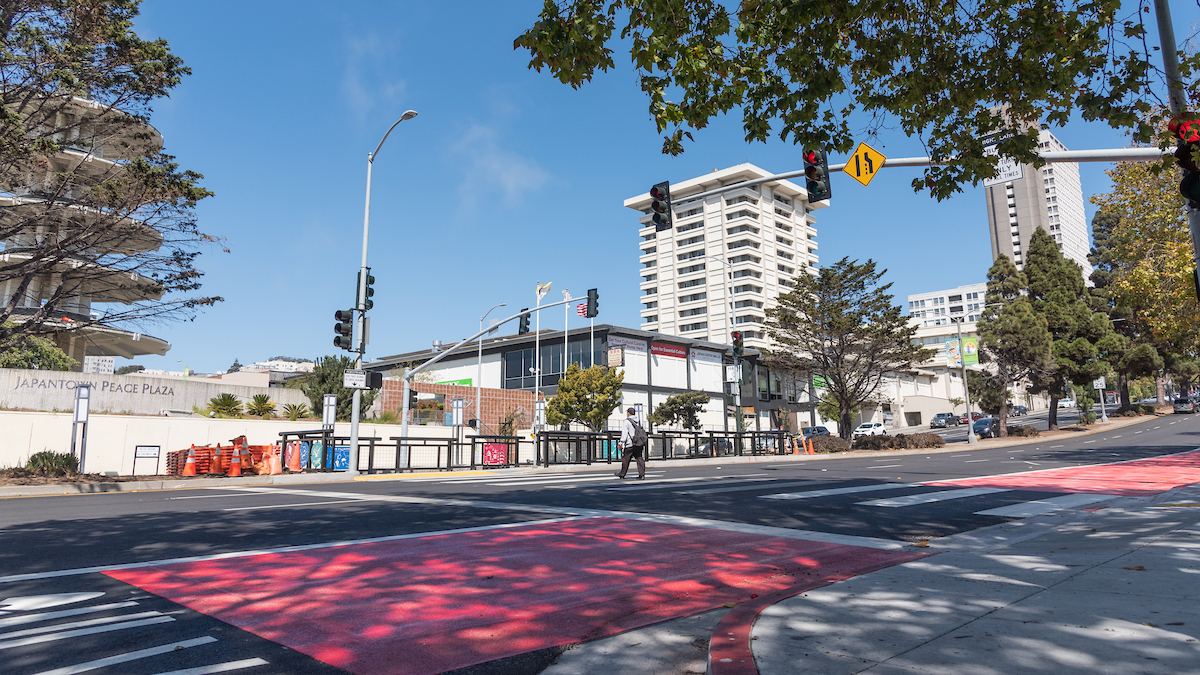
The Geary Rapid Project just met another major milestone with the completion of a long-awaited crosswalk connecting the Japantown Peace Plaza to the southside of Geary Boulevard. The new crossing at Geary and Buchanan Street serves as a physical reconnection to help bridge the gap between divided communities. But it’s also a symbolic one, exemplified by the decorative panels installed in the center median that were inspired and designed by the communities it now serves—the Fillmore, Japantown and St. Francis Square Cooperative.
 A new crosswalk was installed at Geary and Buchanan, with decorative panels representing the surrounding communities.
A new crosswalk was installed at Geary and Buchanan, with decorative panels representing the surrounding communities.
The significance of the crosswalk is tied to the history of the neighborhood.
In the 1960s, the two neighborhoods were specifically targeted by urban planners, the vibrant Fillmore neighborhood --known as “the Harlem of the West” for its phenomenal jazz scene—and Japantown, still struggling after the forced relocation of Japanese-Americans into internment camps. San Francisco, like the rest of the country, had experienced a boom in private automobile ownership, leading many families to leave the urban core and move to more suburban settings. Under the name of "urban renewal," city planners proposed replacing homes in older neighborhoods with bigger, newer buildings, while promising to raise living standards.
In San Francisco, the result of this policy was to force people of color from their homes and shatter communities. In the Western Addition, Black and Japanese-American homes and businesses were torn down and the neighborhoods ripped apart with the construction of the Geary Expressway. This new eight-lane thoroughfare cut communities in half and encouraged motorists to speed past the Western Addition altogether on their way to the western half of the city.
The effects were devastating and have echoed into the present, creating highway-like conditions along Geary that have led to vehicle-pedestrian collision rates eight times higher than the average San Francisco street. While we can never undo the harm that was created by urban renewal and the Geary Expressway, improvements like the new crosswalk at Buchanan, along with other transit and safety improvements, will help to make the neighborhood more safe, walkable and connected.
In addition to the new crossing at Buchanan, four other intersections at Webster, Steiner, Cook and Commonwealth/Beaumont streets have received new signalized crosswalks, along with improved median refuges and Accessible Pedestrian Signals (APS) as part of the Geary Rapid Project.
Another way we can “calm the Expressway” is through a road diet. The number of lanes on Geary was reduced from eight lanes to six, with two general-purpose and one bus lane in each direction. And traffic lanes have been restriped to be visually narrower, which encourages drivers to slow down.
These efforts weren’t created in vacuum. Many elements of the Geary Rapid Project design were developed in partnership with neighboring communities. For example, the 31 new cherry, London plane and Canary Island pine trees that were recently planted between Gough and Divisadero streets were chosen with community input for their cultural significance and suitability for a major thoroughfare. And some proposals, like removing the Webster pedestrian bridge, were abandoned after Japantown advocated to retain the bridge due to its importance both culturally and as a conduit to and from Peace Plaza.
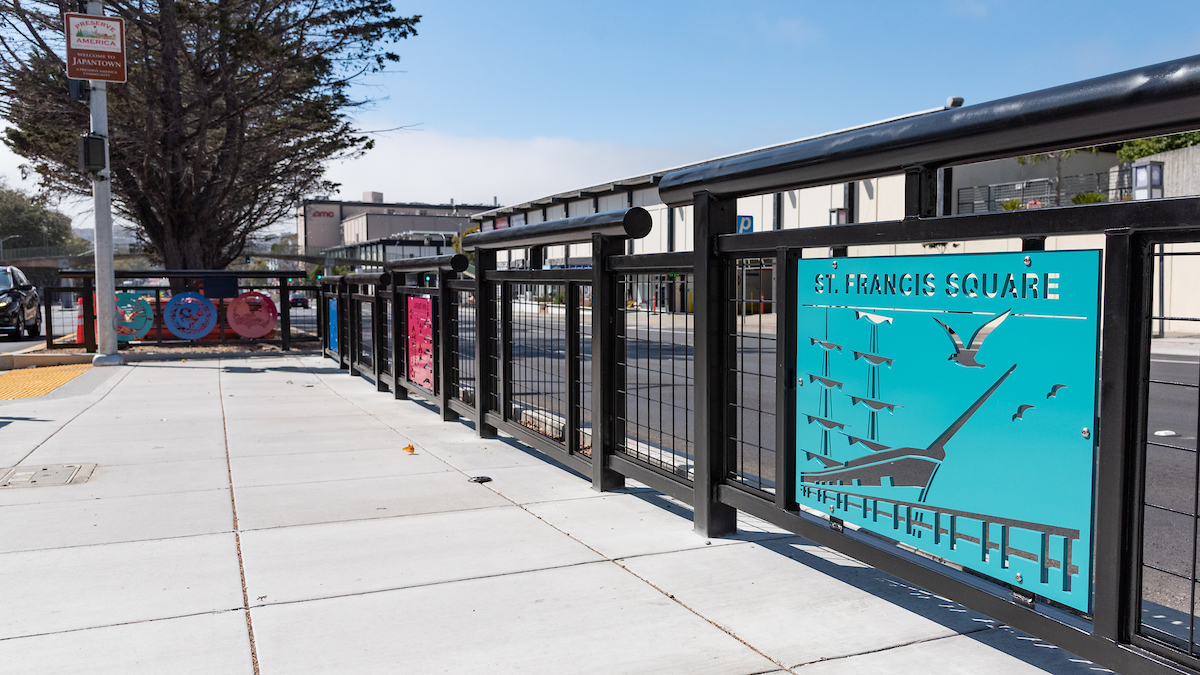 Community input informed the dimensions of the Buchanan crosswalk, which needed to have a large enough median refuge to accommodate groups of Rosa Parks elementary school children.
Community input informed the dimensions of the Buchanan crosswalk, which needed to have a large enough median refuge to accommodate groups of Rosa Parks elementary school children.
The new crosswalk at Buchanan marks the completion of all Geary Rapid Project work West of Van Ness Avenue. The remaining work between Van Ness Avenue and Market Street is expected to be substantially completed within the next month.